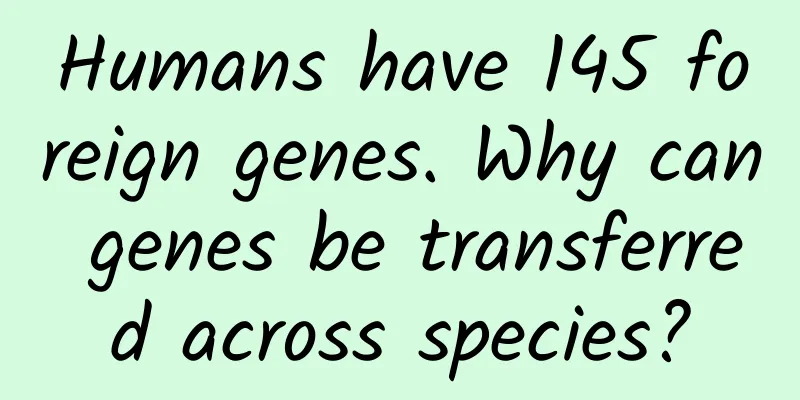Humans have 145 foreign genes. Why can genes be transferred across species?

|
There are genes from other species in the genome of an animal? This phenomenon is now found to be common in nature. Even humans carry 145 foreign genes. In recent years, biologists have also discovered snake genes in frogs. Different species "share" the same gene and enjoy the functions it brings. This may be a gift from our ancestors. Recently, a team discovered a gene transfer event that "just happened". Why can two different species share genes? How did this gene "jump"? New research may give us the answer. Written by Gu Shuchen (Institute of Life Sciences, Zhejiang University) No species is an island. When human ancestors roamed the ancient continent, they passed by many species, which also left their marks on human genes and eventually became ghosts in human genes, quietly describing that period of history. Many years later, scientists suddenly discovered that humans carry 145 foreign genes. About 8% of these genes come from viruses, about 2% come from ancient humans (such as Neanderthals or Denisovans), and some come from bacteria, fungi, or plants and animals [1]. What is horizontal gene transfer (HGT)? Compared with humans, the "reciprocity" in the microbial world is more frequent. Before the Earth was occupied by higher organisms such as humans, microorganisms dominated the Earth. At that time, the living environment was mostly harsh, and many microorganisms lived in places such as volcanic craters and hot springs, so survival was the top priority. Therefore, different microorganisms would exchange more "useful" genes to better adapt to different environments and survive. Although these microorganisms are not related at all, some of their genes have indeed crossed the species barrier and successfully transferred from one microorganism to the genome of another microorganism. This is the "horizontal gene transfer" (HGT) phenomenon, which is a concept opposite to the "vertical gene transfer" (genetic material from parents to offspring) that has received much attention in genetics [2]. In other words, even between species with reproductive isolation, they have the opportunity to receive this "little genetic gift" from their next-door neighbors. As scientists delve deeper into genetic research, they have discovered many examples of horizontal gene transfer, which occurs in both animals and plants. For example, two different fish species living in the polar regions, herring and smelt, “share” the same antifreeze protein that prevents their blood and tissues from freezing in polar waters [3] . In addition, in the tropical rainforests of Madagascar, biologists were surprised to find that in the genomes of local frogs, there is a gene called “BovB” that seems to have originated from snakes (see “Madagascar’s ‘GMO Factory’: Why Do Frogs Have Snake Genes?”) [4]. As more and more examples of horizontal gene transfer are discovered, scientists are more puzzled by the mechanism behind this phenomenon: How do these genes “jump” between different species? Big discovery in tiny nematodes Recently, researchers from Alejandro Burga's laboratory at the Institute of Molecular Biotechnology of the Austrian Academy of Sciences caught an HGT event on the spot. They observed a gene that had just "jumped" in nematodes and found the carrier "Maverick" that helped the gene jump. Mavericks have been detected in various animals, including invertebrates and vertebrates, and they have many characteristics that only viral genes have. Given these properties, biologists suspect that Mavericks and similar genetic factors may have contributed to horizontal gene transfer in the evolution of life. The research results were published in the journal Science on June 30, 2023, with the title "Virus-like transposons cross the species barrier and drive the evolution of genetic incompatibilities" [5]. Scientists discovered this phenomenon "purely by chance". In 2021, Israel Campo Bes, a graduate student in the team, accidentally discovered that this nematode C. briggsae had an almost identical gene with another nematode C. plicata while studying the nematode C. briggsae. Their similarity was amazing, with a nucleotide similarity of nearly 97%. It looks like one nematode copied its genes and somehow pasted them into the genome of the other nematode. This discovery is amazing because C. briggsae and C. plicata are two species with reproductive isolation. The huge difference between their genomes is equivalent to the difference between the genomes of humans and fish. However, they have an almost identical gene, which clearly shows that this is a recent HGT event. This discovery also shocked Alejandro Burga, a molecular geneticist in the laboratory. In order to find out the origin of this "shared" gene, Burga and his team decided to examine the DNA around these "shared" genes. Eventually, they found repetitive sequences around this gene, which is a characteristic of transposons. Transposons are genetic factors that can move within the genome and can insert their copies into different locations of genes by replicating themselves. In addition, they also found some remnants of viral genes: a gene that can express viral capsid proteins, a gene that can promote viral replication, and a "glue" gene for integrating viral DNA into the host genome. These findings indicate that the transferred genes are embedded in a group of virus-like genes and a transposon, which are considered to be part of Mavericks. Not only that, but Mavericks in another nematode species also has an extra gene that expresses a protein called fusogen, which can fuse the virus with the cell's membrane and transfer the viral genome into the cell. Without fusogen, viruses (especially enveloped viruses) have no way to transfer their genes. The presence of this protein strongly suggests that Mavericks can produce virus-like particles and invade different types of cells. Subsequently, Burga's team quickly searched the nematode gene database, and soon they found that this was not an isolated horizontal gene transfer. They found many other examples of genes embedded in Mavericks. In more than 100 nematode genomes across more than 10 genera, there are two genes that are often taken away by Mavericks as "cargo" and widely transmitted between different species. From North America to India, and then to a kilometer-deep gold mine in South Africa, complete and incomplete genetic factors have penetrated into nematode populations in different regions of the world. Although this indirect evidence strongly suggests that Mavericks facilitates horizontal gene transfer between nematode species, biologists have yet to see them in action. So the next step is to find a way to watch Mavericks produce virus-like particles under a microscope and observe every frame of the gene "jumping." The virus-like transposon Maverick can be used as a horizontal gene transfer (HGT) vector. Image source: IMBA-IMP Graphics Inspiration from "Jump" The discovery of this gene “jumping” mechanism has reshaped our understanding of biological evolution. Mavericks are a class of ancient and fragmented jumping genes that are common in the genomes of protists, fungi, and animals (including humans). Initially, people thought that these huge mobile elements were the relics of ineffective and outdated gene mutations. But later studies showed that Mavericks can be reactivated and that they can mediate horizontal gene transfer between certain protists [6]. However, to date, no complete Mavericks has been studied in detail in multicellular animals. This time, nematodes provide us with a rare opportunity, and nematodes are not just model animals for biological experiments. Many nematodes are parasites that can infect crops and livestock. If we can better understand the working principles of Mavericks, perhaps we can use it to introduce specific pathogenic genes into parasites to achieve the purpose of parasite prevention and control. In addition, this discovery also shows that Mavericks can carry certain antiviral and antibacterial genes, which also suggests that it may be used to develop new drugs or vaccines, or to make it a gene transfer tool for applications such as gene therapy and gene editing. There are many cases of horizontal gene transfer through Mavericks or other genetic factors in nature. The horizontal transfer of these genes will affect the genetic diversity and adaptability of species, leading to the formation of new species or the extinction of species. In order to protect species diversity and truly understand the laws of biological evolution, we also need to know more about these vectors that can help genes jump between species. References [1]Crisp A, Boschetti C, Perry M, Tunnacliffe A, Micklem G. Expression of multiple horizontally acquired genes is a hallmark of both vertebrate and invertebrate genomes. Genome Biol. 2015 Mar 13;16(1):50. [2]Nakamura Y, Itoh T, Matsuda H, Gojobori T. Biased biological functions of horizontally transferred genes in prokaryotic genomes. Nat Genet. 2004 Jul;36(7):760-6. [3]Graham LA, Davies PL. Horizontal Gene Transfer in Vertebrates: A Fishy Tale. Trends Genet. 2021 Jun;37(6):501-503. [4]Kambayashi C, Kakehashi R, Sato Y, Mizuno H, Tanabe H, Rakotoarison A, Künzel S, Furuno N, Ohshima K, Kumazawa Y, Nagy ZT, Mori A, Allison A, Donnellan SC, Ota H, Hoso M, Yanagida T, Sato H, Vences M, Kurabayashi A. Geography-Dependent Horizontal Gene Transfer from Vertebrate Predators to Their Prey. Mol Biol Evol. 2022 Apr 10;39(4):msac052. [5]Widen SA, Bes IC, Koreshova A, Pliota P, Krogull D, Burga A. Virus-like transposons cross the species barrier and drive the evolution of genetic incompatibilities. Science. 2023 Jun 30;380(6652):eade0705. [6]Barreat JGN, Katzourakis A. Phylogenomics of the Maverick Virus-Like Mobile Genetic Elements of Vertebrates. Mol Biol Evol. 2021 May 4;38(5):1731-1743. This article is supported by the Science Popularization China Starry Sky Project Produced by: China Association for Science and Technology Department of Science Popularization Producer: China Science and Technology Press Co., Ltd., Beijing Zhongke Xinghe Culture Media Co., Ltd. Note: The cover image is a copyrighted image and its use in reproduction may cause copyright disputes. |
Recommend
The “disappeared” Chunlan: What happened to the former air-conditioning giant and Gree idol?
From being the former overlord of the air-conditi...
Marketing promotion plan: New media marketing hot calendar in May!
Whether it is new media, marketing, event plannin...
Langfang 4.2 magnitude earthquake, why others were woken up by the shaking, but I was sleeping soundly? !
According to the China Earthquake Networks Center...
Want to run a viral marketing campaign? Avoid these 3 misunderstandings first!
When a company plans a marketing campaign, the fi...
Popular Science Illustrations | Looking back at a hundred years of geophysical exploration
Modern oil exploration began in the mid-19th cent...
GTA5 is still in English! 50 pictures to see the Chinese version of XBOX ONE Win10 system update
At 15:11 on the afternoon of November 12, the Chi...
11 low-key but useful details in Android 9.0 Pie
Android 9.0 Pie was officially released a few day...
How to become a "100,000 likes" answerer on Zhihu? The Secrets of the 4 Major Internal Skills
Zhihu, a slow company, has now developed into a u...
It’s a difficult situation for Master Zhou. Is there any hope for Qihoo 360?
On May 6, there were a lot of press conferences i...
Suspended! Why is Super Typhoon Makar so terrifying? What is eyewall replacement?
Audit expert: Ye Haiying Deputy Director of the N...
Look at the product growth of WeChat Reading through the AARRR growth model!
As we enter the second half of the mobile Interne...
Information flow delivery | Core analysis of conversion bidding!
Conversion bidding is the core of information flo...
Lollipops are slowing down, KitKat is still going strong, and Gingerbread is not going away
[[128565]] Google releases Android system version...
A list of plants that are mispronounced | Ficus microcarpa VS Coriander: The name is very "high-end", but the appearance is very ordinary!
The Chinese names of plants are like refined code...
The passion of “Academician Budai” for educating people: after receiving the award, he immediately ran to teach students
On the morning of November 3, 2021, Zhao Dongyuan...









